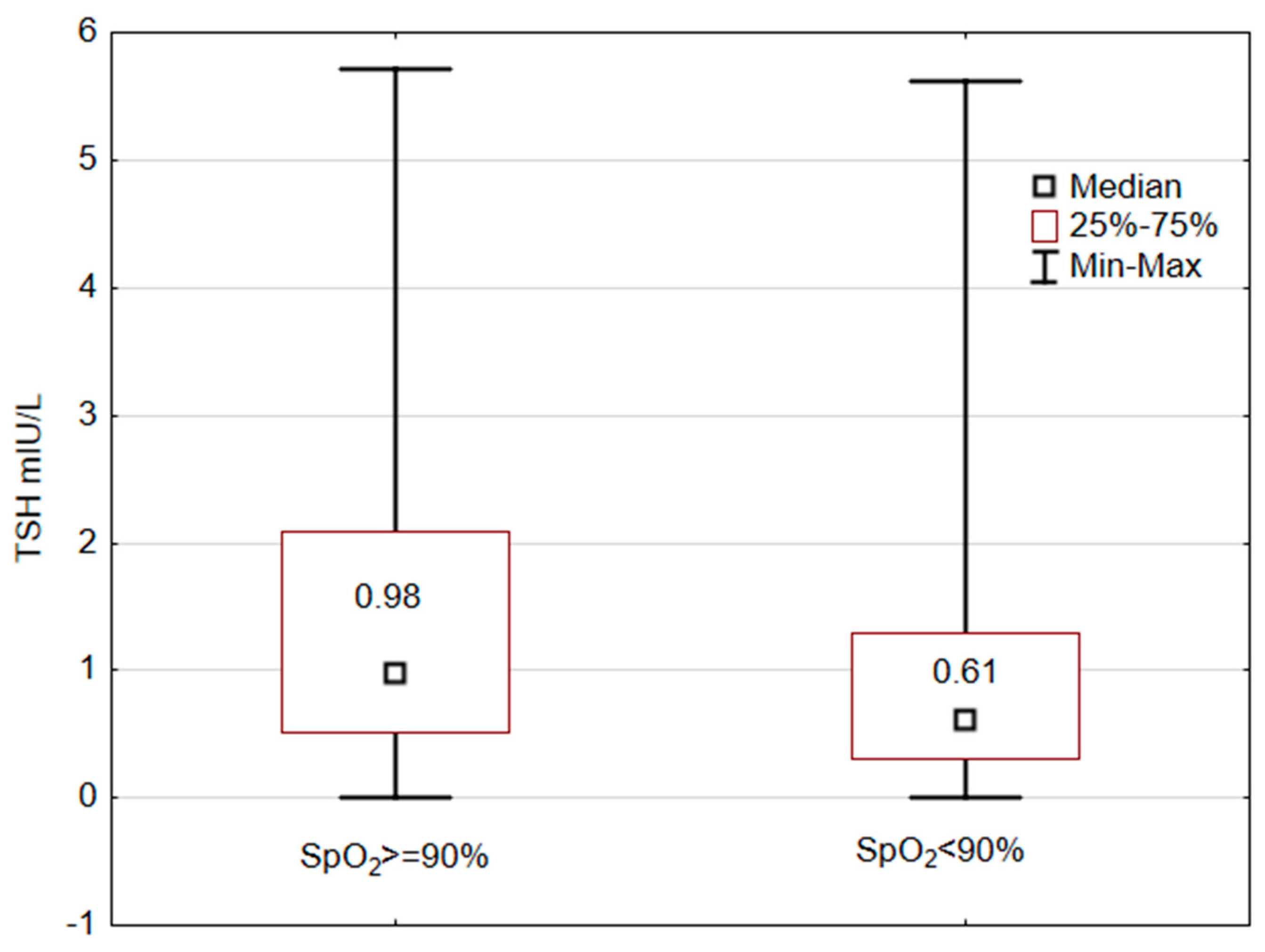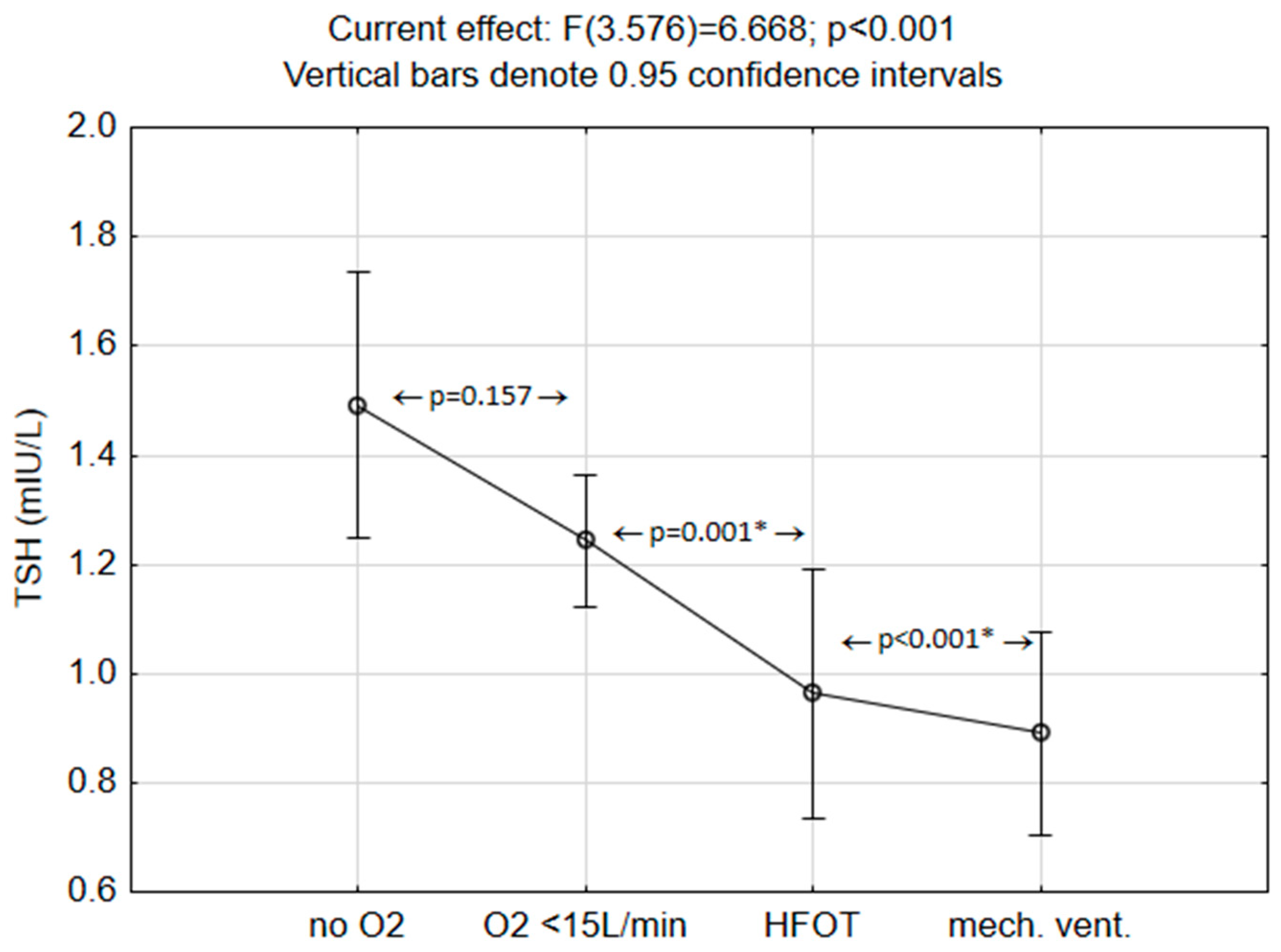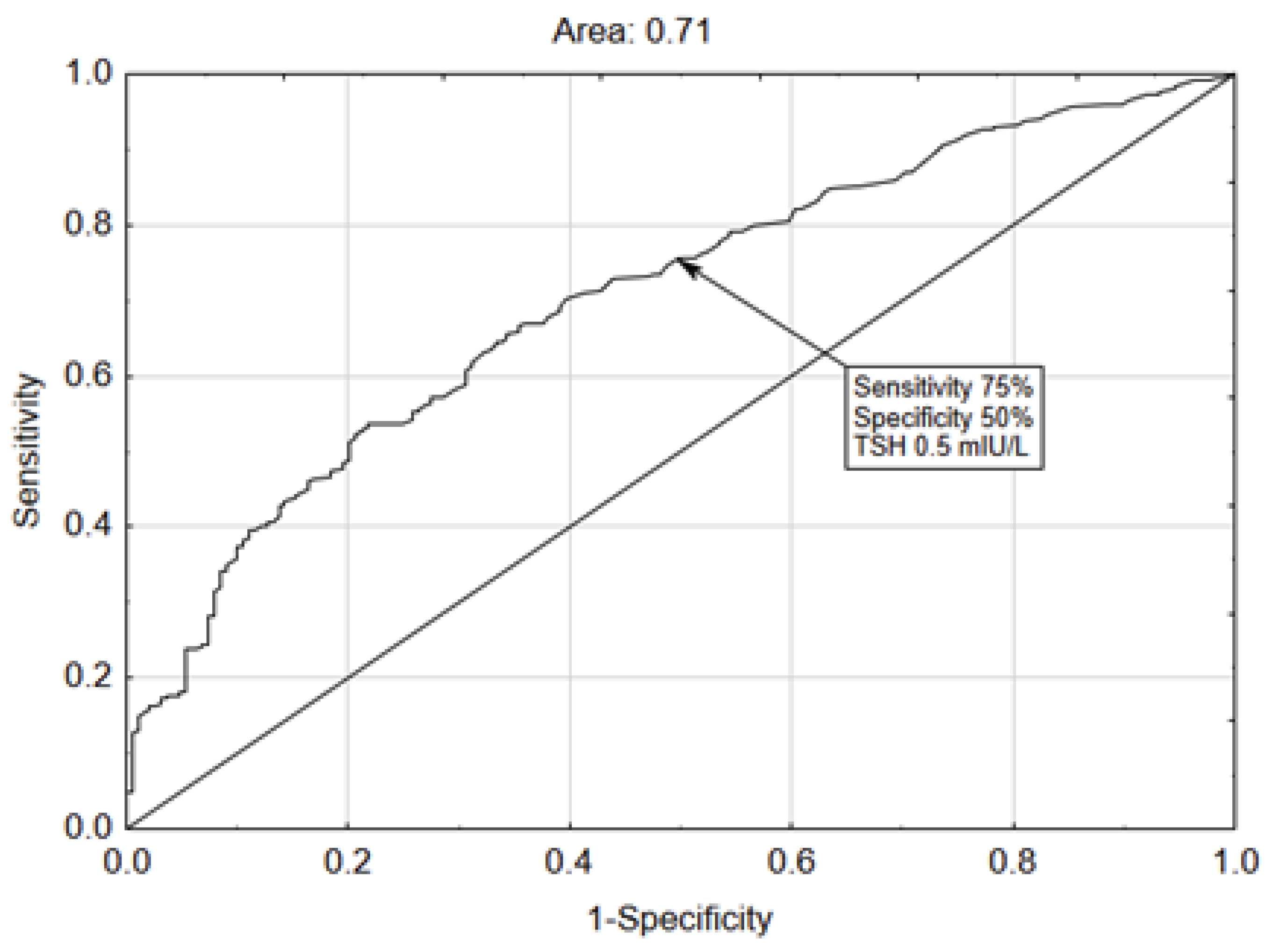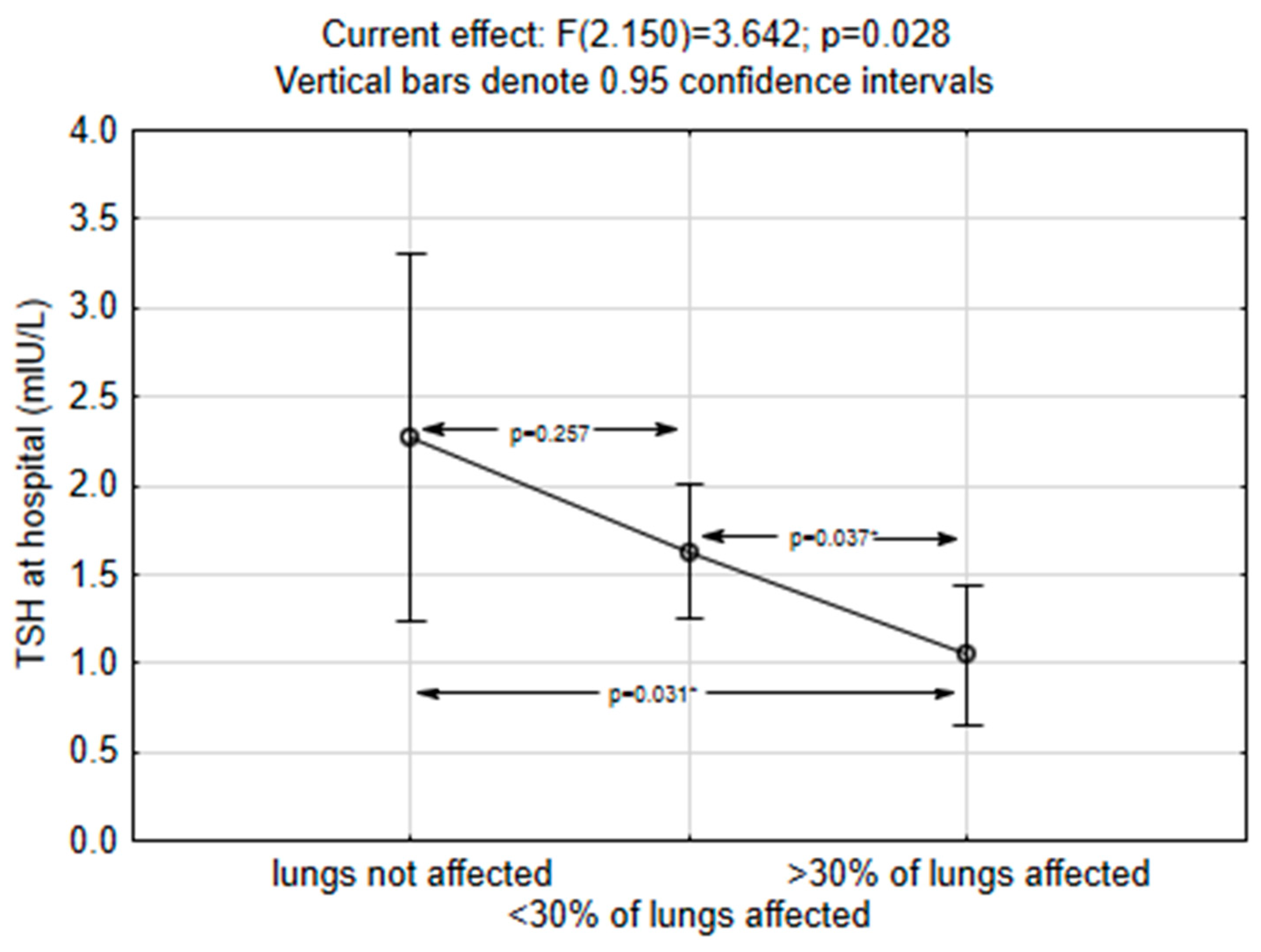Thyroid Stimulating Hormone as a Possible Additional COVID-19 Outcome Marker
Abstract
1. Introduction
2. Materials and Methods
2.1. Study Participants and Data
2.2. Statistical Methods
3. Results
3.1. Short-Term Outcomes and TSH
3.2. TSH as a Predictor of Worse Outcome
3.3. Middle-Term Outcomes and TSH
4. Discussion
5. Conclusions
Author Contributions
Funding
Institutional Review Board Statement
Informed Consent Statement
Data Availability Statement
Conflicts of Interest
References
- World Health Organization. COVID-19 Epidemiological Update, 162nd ed. Available online: https://www.who.int/publications/m/item/covid-19-epidemiological-update---22-december-2023 (accessed on 26 January 2024).
- Ziegler, C.G.K.; Allon, S.J.; Nyquist, S.K.; Mbano, I.M.; Miao, V.N.; Tzouanas, C.N.; Cao, Y.; Yousif, A.S.; Bals, J.; Hauser, B.M.; et al. SARS-CoV-2 Receptor ACE2 Is an Interferon-Stimulated Gene in Human Airway Epithelial Cells and Is Detected in Specific Cell Subsets across Tissues. Cell 2020, 181, 1016–1035.e19. [Google Scholar] [CrossRef]
- Li, W.; Moore, M.J.; Vasilieva, N.; Sui, J.; Wong, S.K.; Berne, M.A.; Somasundaran, M.; Sullivan, J.L.; Luzuriaga, K.; Greenough, T.C.; et al. Angiotensin-converting enzyme 2 is a functional receptor for the SARS coronavirus. Nature 2003, 426, 450–454. [Google Scholar] [CrossRef] [PubMed]
- Lazartigues, E.; Qadir, M.M.F.; Mauvais-Jarvis, F. Endocrine Significance of SARS-CoV-2’s Reliance on ACE2. Endocrinology 2020, 161, bqaa108. [Google Scholar] [CrossRef]
- Li, M.-Y.; Li, L.; Zhang, Y.; Wang, X.-S. Expression of the SARS-CoV-2 cell receptor gene ACE2 in a wide variety of human tissues. Infect. Dis. Poverty 2020, 9, 45. [Google Scholar] [CrossRef] [PubMed]
- Puig-Domingo, M.; Marazuela, M.; Giustina, A. COVID-19 and endocrine diseases. A statement from the European Society of Endocrinology. Endocrine 2020, 68, 2–5. [Google Scholar] [CrossRef]
- Puig-Domingo, M.; Marazuela, M.; Yildiz, B.O.; Giustina, A. COVID-19 and endocrine and metabolic diseases. An updated statement from the European Society of Endocrinology. Endocrine 2021, 72, 301–316. [Google Scholar] [CrossRef] [PubMed]
- ISO 15189:2022; Medical Laboratories-Requirements for Quality and Competence. International Organization for Standardization: Geneva, Switzerland, 2022.
- Hansell, D.M.; Bankier, A.A.; MacMahon, H.; McLoud, T.C.; Müller, N.L.; Remy, J. Fleischner Society: Glossary of terms for thoracic imaging. Radiology 2008, 246, 697–722. [Google Scholar] [CrossRef]
- Chen, W.; Tian, Y.; Li, Z.; Zhu, J.; Wei, T.; Lei, J. Potential Interaction Between SARS-CoV-2 and Thyroid: A Review. Endocrinology 2021, 162, bqab004. [Google Scholar] [CrossRef]
- Speer, G.; Somogyi, P. Thyroid complications of SARS and coronavirus disease 2019 (COVID-19). Endocr. J. 2021, 68, 129–136. [Google Scholar] [CrossRef]
- Muller, I.; Cannavaro, D.; Dazzi, D.; Covelli, D.; Mantovani, G.; Muscatello, A.; Ferrante, E.; Orsi, E.; Resi, V.; Longari, V.; et al. SARS-CoV-2-related atypical thyroiditis. Lancet Diabetes Endocrinol. 2020, 8, 739–741. [Google Scholar] [CrossRef]
- Permana, H.; Soeriadi, E.A.; Damara, F.A.; Soetedjo, N.N.M. The prognostic values of thyroid disorders in predicting COVID-19 composite poor outcomes: A systematic review and meta-analysis. Diabetes Metab. Syndr. 2022, 16, 102464. [Google Scholar] [CrossRef] [PubMed]
- Fliers, E.; Bianco, A.C.; Langouche, L.; Boelen, A. Thyroid function in critically ill patients. Lancet Diabetes Endocrinol. 2015, 3, 816–825. [Google Scholar] [CrossRef] [PubMed]
- Zou, R.; Wu, C.; Zhang, S.; Wang, G.; Zhang, Q.; Yu, B.; Wu, Y.; Dong, H.; Wu, G.; Wu, S.; et al. Euthyroid Sick Syndrome in Patients With COVID-19. Front. Endocrinol. 2020, 11, 566439. [Google Scholar] [CrossRef]
- Chen, M.; Zhou, W.; Xu, W. Thyroid Function Analysis in 50 Patients with COVID-19: A Retrospective Study. Thyroid 2021, 31, 8–11. [Google Scholar] [CrossRef] [PubMed]
- Khoo, B.; Tan, T.; A Clarke, S.; Mills, E.G.; Patel, B.; Modi, M.; Phylactou, M.; Eng, P.C.; Thurston, L.; Alexander, E.C.; et al. Thyroid Function Before, During, and After COVID-19. J. Clin. Endocrinol. Metab. 2021, 106, e803–e811. [Google Scholar] [CrossRef] [PubMed]
- Yao, X.H.; Li, T.Y.; He, Z.C.; Ping, Y.F.; Liu, H.W.; Yu, S.C.; Mou, H.M.; Wang, L.H.; Zhang, H.R.; Fu, W.J.; et al. A pathological report of three COVID-19 cases by minimal invasive autopsies. Zhonghua Bing Li Xue Za Zhi 2020, 49, 411–417. [Google Scholar] [PubMed]
- Wei, L.; Sun, S.; Xu, C.-H.; Zhang, J.; Xu, Y.; Zhu, H.; Peh, S.-C.; Korteweg, C.; McNutt, M.A.; Gu, J. Pathology of the thyroid in severe acute respiratory syndrome. Hum. Pathol. 2007, 38, 95–102. [Google Scholar] [CrossRef]
- Jiménez-Blanco, S.; Pla-Peris, B.; Marazuela, M. COVID-19: A cause of recurrent Graves’ hyperthyroidism? J. Endocrinol. Investig. 2021, 44, 387–388. [Google Scholar] [CrossRef]
- Ippolito, S.; Dentali, F.; Tanda, M.L. SARS-CoV-2: A potential trigger for subacute thyroiditis? Insights from a case report. J. Endocrinol. Investig. 2020, 43, 1171–1172. [Google Scholar] [CrossRef]
- Brancatella, A.; Ricci, D.; Viola, N.; Sgrò, D.; Santini, F.; Latrofa, F. Subacute Thyroiditis After SARS-CoV-2 Infection. J. Clin. Endocrinol. Metab. 2020, 105, dgaa276. [Google Scholar] [CrossRef]
- Lania, A.; Sandri, M.T.; Cellini, M.; Mirani, M.; Lavezzi, E.; Mazziotti, G. Thyrotoxicosis in patients with COVID-19: The THYRCOV study. Eur. J. Endocrinol. 2020, 183, 381–387. [Google Scholar] [CrossRef]
- Duntas, L.H.; Jonklaas, J. COVID-19 and Thyroid Diseases: A Bidirectional Impact. J. Endocr. Soc. 2021, 5, bvab076. [Google Scholar] [CrossRef] [PubMed]
- Owji, M.S.; Varedi, M.; Naghibalhossaini, F.; Pajouhi, N. Thyroid Function Modulates Lung Fluid and Alveolar Viscoelasticity in Mechanically Ventilated Rat. J. Surg. Res. 2020, 253, 272–279. [Google Scholar] [CrossRef]
- Bhargava, M.; Runyon, M.R.; Smirnov, D.; Lei, J.; Groppoli, T.J.; Mariash, C.N.; Wangensteen, O.D.; Ingbar, D.H. Triiodo-L-thyronine rapidly stimulates alveolar fluid clearance in normal and hyperoxia-injured lungs. Am. J. Respir. Crit. Care Med. 2008, 178, 506–512. [Google Scholar] [CrossRef] [PubMed]
- Ahn, J.; Lee, M.K.; Lee, J.H.; Sohn, S.Y. Thyroid Hormone Profile and Its Prognostic Impact on the Coronavirus Disease 2019 in Korean Patients. Endocrinol. Metab. 2021, 36, 769–777. [Google Scholar] [CrossRef] [PubMed]
- Pappa, E.; Gourna, P.; Galatas, G.; Manti, M.; Romiou, A.; Panagiotou, L.; Chatzikyriakou, R.; Trakas, N.; Feretzakis, G.; Christopoulos, C. The prognostic utility of serum thyrotropin in hospitalized COVID-19 patients: Statistical and machine learning approaches. Endocrine 2023, 80, 86–92. [Google Scholar] [CrossRef] [PubMed]
- Güven, M.; Gültekin, H. The prognostic impact of thyroid disorders on the clinical severity of COVID-19: Results of single-centre pandemic hospital. Int. J. Clin. Pract. 2021, 75, e14129. [Google Scholar] [CrossRef]
- Garg, S.; Dabas, A.; Singh, H.; Goswami, B.; Kumar, K.; Dubey, A.; Jhamb, U.; Yadav, S. Thyroid dysfunction in COVID-19. Indian J. Endocrinol. Metab. 2021, 25, 198–201. [Google Scholar] [CrossRef]
- Yazan, C.D.; Ilgin, C.; Elbasan, O.; Apaydin, T.; Dashdamirova, S.; Yigit, T.; Sili, U.; Yagci, A.K.; Sirikci, O.; Haklar, G.; et al. The Association of Thyroid Hormone Changes with Inflammatory Status and Prognosis in COVID-19. Int. J. Endocrinol. 2021, 2021, 2395212. [Google Scholar] [CrossRef]
- Available online: https://clinicaltrials.gov/ct2/show/NCT04115514 (accessed on 27 December 2023).




| Valid N | Mean | Median | Lower Quartile | Upper Quartile | Std.Dev. | |
|---|---|---|---|---|---|---|
| Age (years) | 580 | 66.93 | 68.00 | 59.00 | 78.00 | 13.31 |
| Length of hospitalization (days) | 580 | 16.06 | 13.00 | 8.00 | 21.00 | 10.89 |
| SpO2 at admission | 580 | 88.22 | 90.00 | 85.00 | 95.00 | 9.78 |
| Body temperature at admission (°C) | 580 | 37.71 | 37.80 | 36.50 | 38.70 | 1.18 |
| BMI (kg/m2) | 382 | 29.39 | 28.94 | 25.53 | 32.49 | 5.84 |
| TSH (during hospitalization) (mIU/L) | 580 | 1.16 | 0.790 | 0.38 | 1.62 | 1.08 |
| TSH (post-COVID) (mIU/L) | 207 | 1.99 | 1.680 | 1.15 | 2.41 | 1.51 |
| IL-6 (pg/mL) | 172 | 188.92 | 63.83 | 21.60 | 167.86 | 334.20 |
| CRP (mg/L) | 580 | 104.66 | 86.35 | 39.15 | 153.35 | 84.97 |
| D-Dimer (mg/L) | 436 | 1.72 | 1.12 | 0.60 | 2.50 | 1.45 |
| PCT (ng/mL) | 361 | 1.49 | 0.18 | 0.09 | 0.48 | 7.30 |
| Rank Sum SURVIVED N = 419 | Rank Sum DIED N = 161 | U | Z | p-Value | Z Adjusted | p-Value | |
|---|---|---|---|---|---|---|---|
| TSH (mIU/L) hospitalization | 126,719 | 41,771 | 28,730 | 2.7661 | 0.0057 | 2.7662 | 0.0057 |
| No ICU N = 398 | ICU N = 182 | ||||||
| TSH (mIU/L) hospitalization | 122,284.5 | 46,205.5 | 29,552.5 | 3.5590 | 0.0004 | 3.5591 | 0.0004 |
| Mech. Vent. N = 453 | Mech. Vent. N = 127 | ||||||
| TSH (mIU/L) hospitalization | 138,157.0 | 30,333.0 | 22,205.0 | 3.9306 | 0.0001 | 3.9307 | 0.0001 |
| TSH (mIU/L) Hospitalization | Rank Sum No Cortico | Rank Sum Cortico | U | Z | p-Value | Z Adjusted | p-Value |
|---|---|---|---|---|---|---|---|
| TOTAL | 28,746 | 127,774 | 16,618 | 2.9520 | 0.0032 | 2.9520 | 0.0032 |
| MEN | 4872.0 | 37,614.0 | 3684.0 | 0.7802 | 0.4353 | 0.7802 | 0.4353 |
| WOMEN | 9101.5 | 26,945 | 4578.5 | 2.7627 | 0.0057 | 2.7628 | 0.0057 |
| TOTAL | Mean | Std.Dev. | Diff. | Std.Dev. Diff. | t | df | p |
|---|---|---|---|---|---|---|---|
| TSH (mIU/L) hospitalization | 1.146 | 1.006 | |||||
| TSH (mIU/L) post-COVID-19 | 1.987 | 1.510 | −0.841 | 1.599 | −7.57 | 206 | 0.000 |
| MALE | |||||||
| TSH (mIU/L) hospitalization | 1.180 | 1.211 | |||||
| TSH (mIU/L) post-COVID-19 | 1.897 | 1.459 | −0.717 | 1.591 | −5.12 | 128 | 0.000 |
| FEMALE | |||||||
| TSH (mIU/L) hospitalization | 1.726 | 3.054 | |||||
| TSH (mIU/L) post-COVID | 2.723 | 4.568 | −0.998 | 2.555 | −3.56 | 82 | 0.001 |
Disclaimer/Publisher’s Note: The statements, opinions and data contained in all publications are solely those of the individual author(s) and contributor(s) and not of MDPI and/or the editor(s). MDPI and/or the editor(s) disclaim responsibility for any injury to people or property resulting from any ideas, methods, instructions or products referred to in the content. |
© 2024 by the authors. Licensee MDPI, Basel, Switzerland. This article is an open access article distributed under the terms and conditions of the Creative Commons Attribution (CC BY) license (https://creativecommons.org/licenses/by/4.0/).
Share and Cite
Zrilic Vrkljan, A.; Majic Tengg, A.; Palaversa, T.; Marusic, S.; Ruzic, L.; Bilic-Curcic, I.; Cigrovski Berkovic, M. Thyroid Stimulating Hormone as a Possible Additional COVID-19 Outcome Marker. Medicina 2024, 60, 314. https://doi.org/10.3390/medicina60020314
Zrilic Vrkljan A, Majic Tengg A, Palaversa T, Marusic S, Ruzic L, Bilic-Curcic I, Cigrovski Berkovic M. Thyroid Stimulating Hormone as a Possible Additional COVID-19 Outcome Marker. Medicina. 2024; 60(2):314. https://doi.org/10.3390/medicina60020314
Chicago/Turabian StyleZrilic Vrkljan, Anamarija, Ana Majic Tengg, Tanja Palaversa, Srecko Marusic, Lana Ruzic, Ines Bilic-Curcic, and Maja Cigrovski Berkovic. 2024. "Thyroid Stimulating Hormone as a Possible Additional COVID-19 Outcome Marker" Medicina 60, no. 2: 314. https://doi.org/10.3390/medicina60020314
APA StyleZrilic Vrkljan, A., Majic Tengg, A., Palaversa, T., Marusic, S., Ruzic, L., Bilic-Curcic, I., & Cigrovski Berkovic, M. (2024). Thyroid Stimulating Hormone as a Possible Additional COVID-19 Outcome Marker. Medicina, 60(2), 314. https://doi.org/10.3390/medicina60020314








